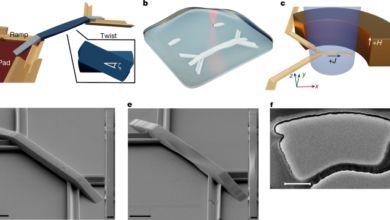Modi bets big on nuclear energy and space


The Indian government wants to expand the country’s space economy fivefold in the next 10 years.Credit: Indranil Mukherjee/AFP via Getty
India’s latest annual budget, the first since Prime Minister Narendra Modi was re-elected for a third term, offers a big push for renewable and nuclear energy, plus extra money to support the country’s burgeoning space industry. The government announced plans to work with the private sector to set up small nuclear reactors and develop nuclear technologies in the quest for energy security.
Finance minister Nirmala Sitharaman, who presented the 2024–25 budget in the Indian parliament on 23 July, said nuclear energy would “form a very significant part of the energy mix” for India’s development. The government also plans to pursue research on small modular reactors, with parts that can be assembled in a factory and transported to the installation site. The exact funds for the nuclear energy plans have not been specified.
The budget commitments for science played out as many researchers expected, with funding announcements for areas of national pride and applied science.
India’s space department will receive 10 billion rupees (US$120 million) to set up a venture-capital fund to support projects that will expand the country’s space economy fivefold in the next 10 years; overall, the department will receive US$156 million, a 4% increase on the 2023–24 budget.
Sitharaman also announced that the Anusandhan National Research Foundation (ANRF) will become operational. The aim of the foundation, first announced in 2019, is to boost funding for university research and to broaden the scope of that research. The ANRF hopes to attract private-sector funding and distribute large grants from a considerable pool of roughly $11 billion.
The combined allocations for key ministries and departments engaged in research — science and technology; agricultural research; atomic energy; earth sciences; health research; new and renewable energy; and space — is $7.1 billion, a 20% increase on the 2023–24 budget. But much of the increase will go to the ministry of new and renewable energy, whose allocation has almost doubled to $2.28 billion in 2024–25 compared with what it was in 2023–2024.
Welcome boost
Heads of key science departments under the ministry of science and technology welcomed the ANRF becoming operational, as well as the new venture-capital fund for the space department and research on climate-resilient agriculture. “Research and development efforts in India are primarily academia-centric, and most often the innovations that occur at the laboratory level fail to get commercialized,” says Rajesh Gokhale, secretary of the department of biotechnology under India’s ministry of science and technology in New Delhi. ANRF funding for basic research and prototype development will pave the way for private-sector-driven research and innovation, he adds.
Geneticist Tapasya Srivastava at the University of Delhi South Campus expects that Sitharaman’s emphasis on employment generation and the internship scheme, a highlight of the budget, will help science students to find work at private companies. In the long run, she says, this will “encourage students to take up science as a career, with more opportunities beyond academia”.
Real money
But others were less impressed. “What is important is not the funds promised in the budget, but the quantum actually released during the year, which is typically less than the promise,” says geneticist Subhash Lakhotia at Banaras Hindu University in Varanasi. “The amount actually available to individual researchers in real terms is relatively reduced, due to inflation, enhanced emoluments and the increasing numbers of researchers competing for the limited money.”
India spent 0.64% of its gross domestic product (GDP) on research and development during 2020–2021. That compares with an average of 2.7% in the 38 high-income countries in the Organisation for Economic Co-operation and Development in 2022, and with China’s 2.4% in 2021.
Lakhotia doubted whether the money for research this year would increase India’s investment in research as a percentage of GDP.
C. P. Rajendran, a geologist at the National Institute of Advanced Studies in Bengaluru, agrees. “The budget allocation for science in India continues to be dull with some nominal increase,” he says. “There is nothing much to be excited about.”





